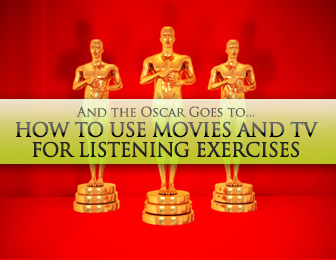And the Oscar Goes to... How to Use Movies and TV for Listening Exercises


Watch how excitedly your learners will respond to these real-world listening exercises that break the mold on the usual, hum-drum book exercises!

eHow is an unbeatable resource for ESL teachers. EHow furnishes a variety of how to videos in every category and subject you can think of. Just a few of the options are: health, parenting, gardening, arts, travel, business, careers, fashion, etc . The list goes on and on, and you can easily pinpoint what you are looking for by doing google-like searches. Be sure to involve the students in the choice of the types of videos they will watch, and also decide whether they will do individual or group activities. If students have access to computers, it is an effective site for them to spend some time browsing around for topics that appeal to them, and possibly for building ideas for project-based work. You can have students do homework exercises, or in-class listening exercises and discussions. One other option is to first present a video to the entire class with no sound. See if they can determine the subject of the video, pick out some words by reading lips, or discuss things like eye contact or body language. You can then follow that up with your listening activities.
The videos are short, usually between two to three minutes, so organizing lessons around the theme of the video is pretty simple. The speakers are diverse, and most often subject matter exerts in the particular topic, which lends credibility to what the students are viewing. American accents are the most common, but students will also be exposed to many types of people, all with a variety of regional accents. Because the topics are very specific, the videos present in a very conversational way. The people featured don't talk exceptionally fast or slow. Every video is accompanied by a word-for-word transcription which you can include in exercises or debriefs. It's also productive for students to observe up-close a person talking about a topic that is familiar and interesting to them. Use eHow as an opportunity to go beyond just answering comprehension questions. Challenge students to make observations about intonation and tone, decipher idiomatic speech, pick out new vocabulary, or examine body language and facial expressions.
Speaking of videos, do you ever use You Tube in your classroom? One of the best ways to utilize You Tube is to locate interviews to grab students' attention. Students in all countries love famous people, and one great motivator is to allow them to watch interviews of their favorite stars. It's easy to search and locate video clips from a range of talk shows and other sources. You can find almost anyone, from the Spice Girls to Justin Bieber to Julia Roberts. You Tube is archived so you can locate interviews from ten years ago, or find the latest and and greatest. It's fun to have students explore interviews from a long time ago and then have them make observations. The observations can be things like physical appearance, changes in idiomatic language, or reference in the conversation that strike them as outdated or different from modern times.
There are a lot of options for how you can organize these lessons. You could have students listen for very particular things like how many times they can count hearing a certain grammar point or expression. You could give students a list of comprehension questions that they determine through a certain amount of viewings. You can devise all kinds of creative and entertaining ways to use these You Tube interviews to further students' listening skills. Go for general comprehension or very pointed themes, but whatever you choose be sure that you allow the students to explore, listen repeatedly, and discover new things for themselves.
News is a great source for natural listening exercises, and also for building vocabulary. You can either enlist the help of the internet or do it the old fashioned way and assign students some TV viewing. Whichever way you choose, you want to be very specific about the goal of the listening and what you want students to take away from the newscast. It is easy to find local news clips that include headlines, weather, problem solvers, and other specific segments that you can tailor your lesson to. With all good listening exercises, you want to focus on vocabulary and speech delivery. Utilizing local news works really well because newscasters use a different type of speech and vocabulary. Students may also be familiar with some of the local TV personalities. You may want to do some lead up lessons where students analyze how news is delivered, have them discuss their favorite anchor people, or use the news as a jumping off point for current events discussion or debates. If you can wrap in other facets before you approach the listening exercises, students will be confident about the subject matter and will most likely be very excited to get to watch TV as a part of class work.
Not only will it be entertaining, but students will listen intently and never forget these memorable real-world activities.